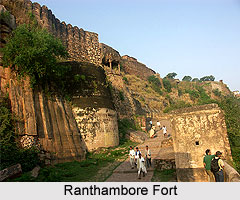 Ranthambore Fort is one of the oldest structures in the state of Rajasthan. This historical fort is located near Sawai Madhopur town of the state. Ranthambore National Park is named after the 10th century Ranthambore fort, which covers the entire top of a hill at the heart of the Park. The Ranthambore fort, in turn, is said to have got its name from two adjoining hills - Rann and Thambhore. It lies on the Thambhore hill, overlooking Rann and offers some breathtaking views of the national park. Ranthambore Fort was established by the Chauhan Rajputs in 944.
Ranthambore Fort is one of the oldest structures in the state of Rajasthan. This historical fort is located near Sawai Madhopur town of the state. Ranthambore National Park is named after the 10th century Ranthambore fort, which covers the entire top of a hill at the heart of the Park. The Ranthambore fort, in turn, is said to have got its name from two adjoining hills - Rann and Thambhore. It lies on the Thambhore hill, overlooking Rann and offers some breathtaking views of the national park. Ranthambore Fort was established by the Chauhan Rajputs in 944.
In the geography of ancient India Ranthambore Fort was strategically located. As a result a lot of wars were fought to conquer the fort. From Ala ud din Khilji to Akbar, the emperors had always attempted to capture the fort. Amidst this the only ruler who had ruled comfortably for a long time was Rao Hammir. He descended the throne in the 11th century. In the later half of the 19th century the fort was handed over to the ruler of Jaipur, Sawai Madho Singh by the Mughal Emperors. It was he who built the city of Sawai Madhopur around the fort. From then on the fort remained with the Rajputs and the adjacent forest area became their favourite hunting ground. This area was later given the status of a national park. Today, Ranthambore National Park is considered as one of the important tourist destinations in the country.
The walls of Ranthambore Fort are about 7 kilometres in length and include an area of nearly 4 square kilometres. The Ranthambore fort is bounded by huge stonewalls which are reinforced by towers and bastions. The stone for the masonry was mined from inside the fort and the mines were later turned into ponds for water storage. The main approach to Ranthambore Fort lies through a narrow valley, which had four fortified gateways. There are many ruined buildings inside the Ranthambore Fort, with Hammir`s Court, Badal Mahal, Dhula Mahal and Phansi Ghar being the most prominent of them. The Fort also has many cenotaphs, temples and gates. Temples dedicated to Lord Ganesha, Goddess Chamunda and other gods are also found here. The Ganesh Temple, which lies very close to the main entry gate to the fort, attracts a large number of pilgrims. During the annual Ganesh festival, thousands of pilgrims visit the temple, from far and wide. Besides such buildings the fort also offers a panoramic view of the surrounding area.
All around the fort, one can see many old ruins, including palaces, temples, cenotaphs, step-wells and houses. The fort is a must see for all visitors.
How to reach Ranthambore Fort, Sawai Madhopur, Rajasthan:The reserve is located near the Town of Sawai Madhopur which lies on the Main Mumbai - Delhi railway Line.
Nearest Railway Station : Sawai Madhopur .Sawai Madhopur is directly connected by rail to Mumbai / Delhi / Kolkata / Jaipur / Bangalore / Hyderabad / Chennai / Bhopal / Patna / Ahmedabad and many other towns in India.
Nearest Airport : Jaipur - 190 kms from airport to Ranthambhore via Tonk.



















